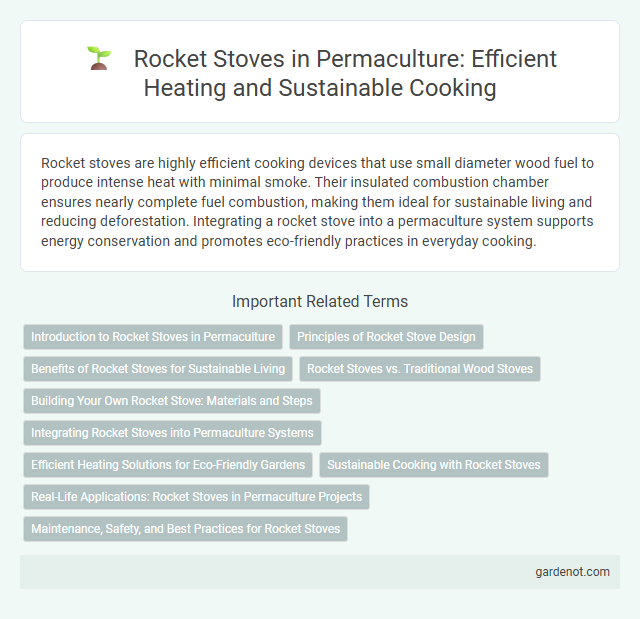Rocket stoves are highly efficient cooking devices that use small diameter wood fuel to produce intense heat with minimal smoke. Their insulated combustion chamber ensures nearly complete fuel combustion, making them ideal for sustainable living and reducing deforestation. Integrating a rocket stove into a permaculture system supports energy conservation and promotes eco-friendly practices in everyday cooking.
Introduction to Rocket Stoves in Permaculture
Rocket stoves in permaculture optimize fuel efficiency by using insulated combustion chambers to achieve higher temperatures with minimal wood consumption. Their design promotes clean burning, reducing smoke and harmful emissions, making them ideal for sustainable living and off-grid cooking. Integrating rocket stoves within permaculture systems supports eco-friendly energy use and enhances resource conservation.
Principles of Rocket Stove Design
Rocket stove design principles emphasize high combustion efficiency and minimal fuel use by optimizing airflow and insulation. The L-shaped combustion chamber ensures complete fuel burning with a strong draft that channels heat effectively through the insulated vertical chimney. Durable materials like firebrick maximize heat retention, enabling sustained cooking temperatures with reduced smoke and emissions.
Benefits of Rocket Stoves for Sustainable Living
Rocket stoves maximize fuel efficiency by burning small amounts of biomass with high heat output, reducing wood consumption and lowering carbon emissions in sustainable living practices. Their compact and portable design enables off-grid cooking and heating, minimizing reliance on fossil fuels and electricity. Enhanced combustion efficiency produces less smoke and indoor air pollution, promoting healthier living environments while supporting eco-friendly resource management.
Rocket Stoves vs. Traditional Wood Stoves
Rocket stoves significantly outperform traditional wood stoves by maximizing combustion efficiency and reducing fuel consumption through their insulated combustion chamber and precise airflow design. These stoves produce higher temperatures with minimal smoke emissions, leading to cleaner burns and improved indoor air quality. Rocket stoves are ideal for sustainable living and permaculture systems by minimizing environmental impact and conserving resources.
Building Your Own Rocket Stove: Materials and Steps
Building your own rocket stove requires basic materials such as insulated metal pipes, fireproof bricks or clay, and a sturdy base like cinder blocks or steel sheets. Start by assembling the L-shaped combustion chamber using the metal pipes, ensuring an insulated neck for efficient airflow and intense heat generation. Finish by securely stacking the fireproof bricks around the combustion chamber to retain heat and stabilize the structure for safe, fuel-efficient cooking.
Integrating Rocket Stoves into Permaculture Systems
Integrating rocket stoves into permaculture systems enhances energy efficiency by minimizing fuel consumption and reducing smoke emissions through advanced combustion technology. Their compact design supports sustainable cooking practices while producing biochar, which enriches soil fertility and promotes healthier plant growth. Utilizing locally sourced biomass aligns with permaculture principles of resource conservation and closed-loop ecological cycles.
Efficient Heating Solutions for Eco-Friendly Gardens
Rocket stoves provide efficient heating solutions by utilizing a high-combustion system that maximizes fuel efficiency and minimizes smoke emissions, making them ideal for eco-friendly permaculture gardens. Their compact design allows for focused heat delivery to garden beds or small structures, reducing energy waste and promoting sustainable resource use. Incorporating rocket stoves enhances thermal management while supporting organic growth and reducing carbon footprints.
Sustainable Cooking with Rocket Stoves
Rocket stoves use efficient combustion technology to minimize fuel consumption and reduce smoke emissions, promoting sustainable cooking practices. These stoves burn small-diameter wood and organic waste, making them ideal for off-grid and permaculture environments where resource conservation is essential. By maximizing heat output and lowering environmental impact, rocket stoves support eco-friendly food preparation and reduce deforestation risks.
Real-Life Applications: Rocket Stoves in Permaculture Projects
Rocket stoves, with their high combustion efficiency and low smoke output, are integral to permaculture projects for sustainable cooking and heating. By utilizing locally sourced biomass, these stoves reduce fuel consumption and minimize environmental impact while providing reliable thermal energy for food preparation and small-scale processing. Their compact design and ease of construction enable seamless integration into off-grid permaculture systems, enhancing energy self-sufficiency and resilience.
Maintenance, Safety, and Best Practices for Rocket Stoves
Regular maintenance of rocket stoves involves clearing ash buildup and inspecting the combustion chamber for cracks to ensure efficient burning and prevent smoke leakage. Safety measures include placing the stove on a stable, non-flammable surface and keeping flammable materials at a safe distance to minimize fire hazards. Best practices recommend using dry, seasoned wood for fuel and monitoring airflow to optimize combustion efficiency and reduce emissions.
Rocket stove Infographic

 gardenot.com
gardenot.com